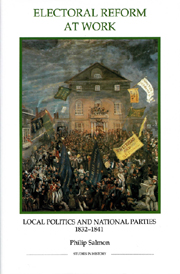Book contents
- Frontmatter
- Contents
- List of illustrations
- List of figures
- List of tables
- Dedication
- Acknowledgements
- Abbreviations
- Introduction
- PART I THE REFORMED ELECTORAL SYSTEM
- PART II THE COUNTIES
- 4 Electoral behaviour in the counties: influence and independence
- 5 County politics and registration: case studies
- PART III THE BOROUGHS
- Appendices
- Bibliography
- Index
5 - County politics and registration: case studies
from PART II - THE COUNTIES
Published online by Cambridge University Press: 12 September 2012
- Frontmatter
- Contents
- List of illustrations
- List of figures
- List of tables
- Dedication
- Acknowledgements
- Abbreviations
- Introduction
- PART I THE REFORMED ELECTORAL SYSTEM
- PART II THE COUNTIES
- 4 Electoral behaviour in the counties: influence and independence
- 5 County politics and registration: case studies
- PART III THE BOROUGHS
- Appendices
- Bibliography
- Index
Summary
It has long been recognised that national political history can only really be written ‘on an established basis of local history’. Countering the thematic approach adopted elsewhere in this book, this chapter presents a detailed analysis of six county divisions during the post-Reform decade. Although each study is firmly rooted within its local context, particular attention has been paid to the role of landed influence and the impact of registration activity, the former because it has hogged so much of the historiographical debate and the latter because it continues to be widely regarded as mainly a borough phenomenon. The following surveys of North Devon, South Lincolnshire, Bedfordshire, West Somerset, North Wiltshire and the West Riding of Yorkshire demonstrate that in these county divisions, at least, partisan registration activity became decisive in determining the outcome of elections and the fortunes of political parties.
The choice of these constituencies was largely determined by the need to avoid an over-reliance on newspaper accounts, with their highly partisan reports of local registration activity, and the availability of suitable archive material relating to the work of local agents and activists on the ground. But the counties selected also differ markedly in terms of their electoral size and structure, and in their patterns of landownership and political control. focusing on those electoral processes which were at work in all county divisions, however, these regional variations have not prevented the creation of an overall synthesis appropriate to the reformed county electorate as a whole.
- Type
- Chapter
- Information
- Electoral Reform at WorkLocal Politics and National Parties, 1832–1841, pp. 146 - 182Publisher: Boydell & BrewerPrint publication year: 2002

